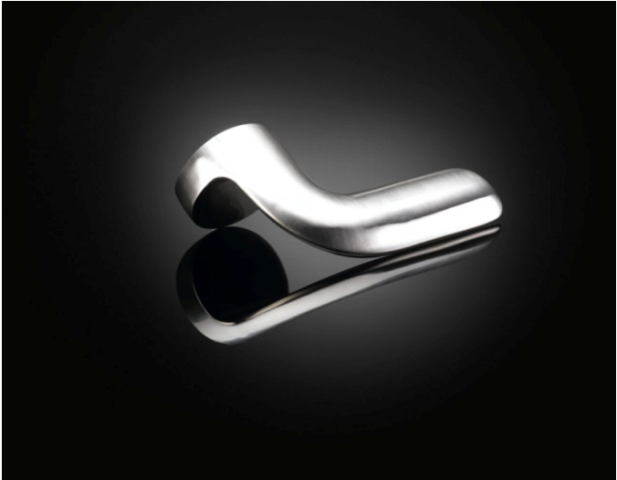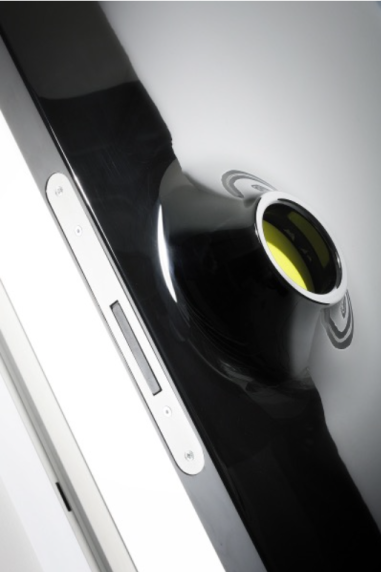‘A door handle is the handshake of a building,’ Adriana Natcheva, Architect.

Unknown Source
It’s staggering to think that door knobs/handles are a relatively recent invention. It is worth pointing out the distinction between the two: A door handle is a lever operated device while a door knob is usually shaped like a globe. Knob or lever handle? It really comes down to personal preference. In essence they both perform the same function and both have their pros and cons. (Opening door knobs with wet/greasy hands is tricky, getting clothes caught in lever handles is a pain, door knobs are preferable in Canada to prevent bears from wondering into homes! etc.) Levers are often perceived as a more high-end or elegant form of door hardware than the common door knob. However, it also comes down to cultural tradition. In the US, for instance, door knobs seem to be more popular although lever handles are often used in public buildings to conform to certain regulations as they are easier to operate by disabled and elderly people or even children. Interesting fact: in Vancouver, door knobs have been banned in favour of a less discriminatory, more universal lever design.
It is hard to pinpoint exactly when the modern door handle/knob came into being but from 1830 to 1873 the US patent office granted over 100 patents for door knobs. It is extraordinary to think that such a common item like the door knob that turns and enables a door to open only really came into existence in the late 1800s! In 1878 the US patent office granted a patent for an actual door closing device. This gave way to the first internal door latching mechanism.
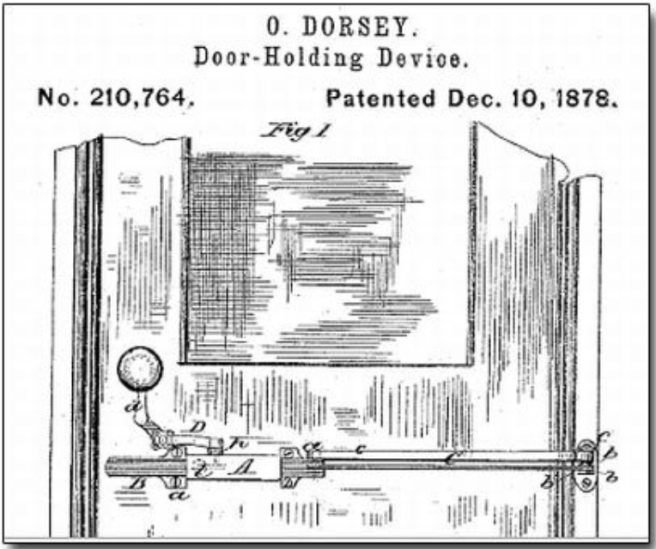 Part of the design submitted by Osbourn Dorsey to the US Patent Office
Part of the design submitted by Osbourn Dorsey to the US Patent Office
Locks with keys have existed for much of history; however they were only accessible to those wealthy enough to have locks fitted. The majority of people simply used hide or textiles for doors and when wooden doors were introduced (difficult to date) a simple latch string mechanism was common.

Latch string mechanism
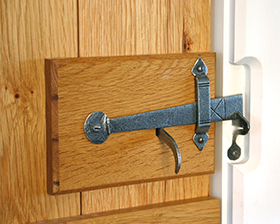
Common latch door
Solid doors, latches and modern-day closing/locking mechanisms emerged out of a need for safeguarding personal possessions and valuables, as well as ensuring personal safety and privacy. Before whole rooms could be locked, personal belongings were kept in boxes and chests which could be locked with a key. Humans are naturally acquisitive and our possessions almost become an extension of ourselves. They often reflect who we are – or at least how we’d like to think of ourselves- and how we want to be perceived. It is natural that we feel the need to safeguard our belongings.
Nowadays, of course, door handles are so much more. They are not only a functional item but also an important design element of a home or other building. There is a staggering array of handles to choose from. I have been living through a house refurbishment for the last three years and have witnessed how long it has taken my family to make a seemingly straightforward decision of what door handles to buy. In fact, two downstairs doors have had no form of handle or knob for 18 months!
Our current fascination with interior design means that those who are interested in the fine details or the design elements of a home, space or public building, will spend quite some time poring over these decisions. A door handle can set the tone of the room being entered into; it can reflect not only the style of a space but also the personality of those occupying it; it has to work as a functional item but for many people it has to work with their aesthetic sense.
Personally, I love the contemporary designers who are totally breaking with convention and introducing the element of surprise in door furniture but I’m also interested in exploring extraordinary, unique and intricate designs made out of more traditional or ‘old fashioned’ materials such as bronze, brass or copper.
–
The vast array of door handle styles, shapes, colours, finishes and prices naturally make the choice incredibly difficult. Of course not everyone will agonise over such decisions but if we go back to the premise that we are naturally acquisitive beings, and often define ourselves by our possessions, seemingly simple decisions can be tricky. Generally, the choice people make about door handles will be consistent with the overall style of their homes.
Many contemporary designers, such as Philippe Starck, have come up with inventive takes on standard models. In fact, in the picture below he seems to have come up with a cross between a knob and a handle which appears to be rather more ergonomic than a traditional knob.
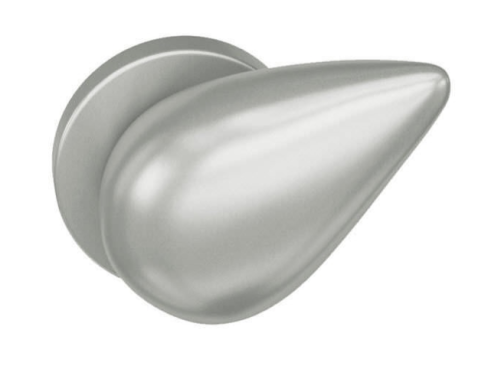
Model 23 0839 for FSB by Philippe Starck
I suppose that the challenge for contemporary product and industrial designers is to come up with exciting and innovative designs for these everyday objects. Consumers need to assert their individuality; given that their possessions and homes are a reflection of their tastes and personalities they are no longer happy with the ubiquitous bent tube mounted on a round rose in a satin chrome or polished chrome finish as in the image below. This was once at the cutting edge of contemporary design but it has become so commonplace it no longer does the job of creating an interesting focal point on a door and it no longer interests many consumers and homeowners.
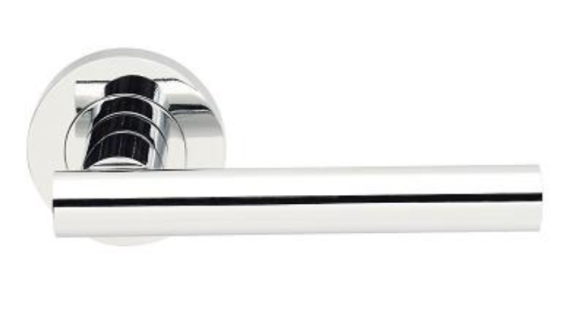 Common handle on round rose
Common handle on round rose
Many designers will make subtle changes to this universal design. They will rethink and subvert it so that the run-of-the-mill becomes special. Sebastian Berge, for instance, is a contemporary industrial designer who likes to introduce humour and humanity into the objects that he creates. The Iota lever handle that he has created for Izé is unusual in that the neck becomes the rose quite seamlessly so the handle looks almost like an integral part of the door. It is also visually lighter and has a unity of form which makes it a lot more interesting. It is a subtle alteration but it makes a large impact.
Iota lever handle designed by Sebastian Bergne
Not all designers have approached the reinvention of this everyday object in such a subtle way. Some modern creations are unapologetically unconventional and will appeal to some people’s sense of fun and playfulness. Of course, designers must marry form and function when coming up with quirky and truly imaginative door handles. Oddly enough, designer Karim Rashid has done away with the door handle altogether. He completely defies our expectations of what a modern door should look like with his Ring and Blow doors. Embracing the minimal, the Ring door contains the opening mechanism within a ‘volcano’ which means that in order to open the door your hand practically disappears into it. A novel approach altogether. Similarly, I have come across knobs that retract when they are locked and spring back out when they are unlocked.
Ring door by Karim Rashid
Most of the time, however,the point is not to fully conceal the handle or knob but to make it the focal point of the door, to add a decorative touch. Product and industrial designers, and even architects are trying their hand at multipurpose door handles. Not merely marrying form and function but adding a secondary function too! So, nowadays we can find anything from self-sterilising handles through handles that can scan fingerprints, that have integrated door stops or flashlights, that double as nightlights, that also function as doorbells, to ones that display a reflection of the room on the other side of the door, and others that can actually be bent and shaped to perform a multitude of tasks!
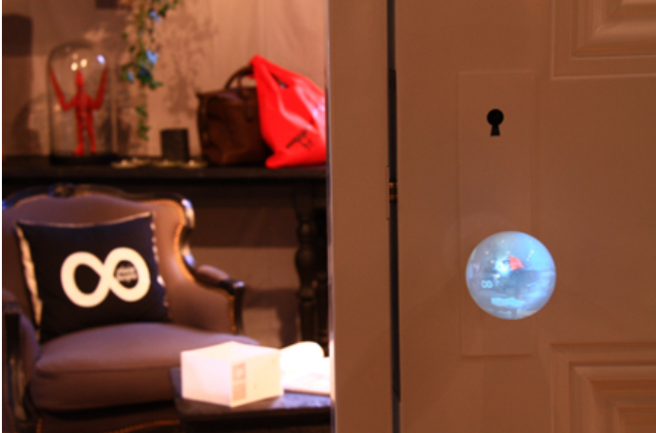
Hideyuki Nakayama’s “A Room in the Glass Globe,”
Kobu door handle ny Diego Amadei has a flexible stem and can be bent to perform a multitude of tasks
As for door handles being objects through which users can assert their identities, how about this one?! Schmitz Thomas’ Possibilità is based on the idea that ‘ life is always a state of improvisation’. There is a slot for users to insert the handle of their choice… sticks, pencils or sausages!

Possibilità by Schmitz Thomas
I quite like the idea of door handles giving a strong clue as to the purpose of the space one is entering, in other words, introducing the space. They can appear quite eccentric but why not introduce at just below eye level the space you are entering? The Sneakerknob, for example, is an exact replica of an Air Max trainer made of either aluminium or bronze and adorns the doors of a few shoe shops. Like it or loathe it, I think that not only does it leave the passer-by with a pretty good indication as to the nature of the store but it quite possibly attracts them into the store too.
Sneakerknob designed by Metrofarm
In a similar vein, I have come across a restaurant that has a knife and fork as door handles and a café which has placed on their entrance door a croissant-shaped handle.
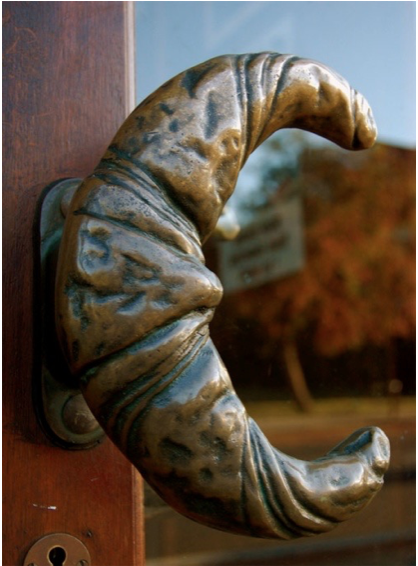
Croissant-shaped door handle
–
Door handles come not only in a fascinating range of styles but also in a vast selection of materials. In Victorian times the best quality handles were made from cast brass or bronze. In the late 1800s composite metal knobs were introduced as a less expensive option. Nowadays it is quite common to see them made out of wood, ceramic, glass, plastic and various types of metal. It would appeal to my particular interests to design something that not only is decorative but also serves a very specific purpose.
During my research into this particular area of door hardware, I found myself drawn to the quirkiness of some handles and knockers as they appealed to my sense of humour. Brass and copper are materials that I do especially like for handles although my experience of working with these materials is non-existent. I will be exploring other options in order to create my own original and unique door pull or knocker.



